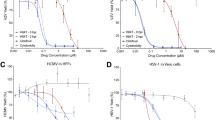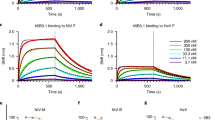Abstract
Sexual transmission is the most frequent (86%) route of adult HIV–1 transmission worldwide1. In the absence of a prophylactic anti–HIV vaccine, other methods of preventing infection should be implemented. Virucidal spermicides have been considered for this purpose, but their application is contraindicated by adverse effects2. Anti–HIV drugs3 or virus–neutralizing monoclonal antibodies4 are expensive, suggesting that their wide use in topical chemoprophylaxis is unlikely. This emphasizes the importance of developing other methods for preventing HIV transmission. The target cells for sexual and mucosal HIV transmission include T lymphocytes, monocytes/macrophages and dendritic cells5. Therefore, compounds blocking HIV–CD4 binding are expected to inhibit virus transmission. In exploring the possibility that chemical modification of food proteins might lead to compounds with anti–HIV–1 activity, we found that bovine (β–lactoglobulin (β–LG) modified by 3–hydroxyphthalic anhydride (3HP–β–LC) (1) blocked at nanomolar concentrations the binding to CD4 of human (HIV) and simian (SIV) immunodeficiency virus surface glycoproteins and monoclonal antibodies specific for the HIV binding site on CD4 and (2) inhibited infection by HIV–1, including primary virus isolates, by HIV–2 and by SIV. The inexpensive and widely available source (whey) for production of 3HP–β–LG suggests its potential application (nonparenteral) for diminishing the frequency of HIV transmission.
This is a preview of subscription content, access via your institution
Access options
Subscribe to this journal
Receive 12 print issues and online access
$209.00 per year
only $17.42 per issue
Buy this article
- Purchase on Springer Link
- Instant access to full article PDF
Prices may be subject to local taxes which are calculated during checkout
Similar content being viewed by others
References
Mann, J.M., Tarantola, D.J.M. & Netter, T.W. AIDS in the World (Harvard University Press, Cambridge, 1992).
Bird, K.D. The use of spermicide containing nonoxynol-9 in the prevention of HIV infection. AIDS 5, 791–796 (1991).
Steele, F. AIDS drugs lurch towards market. Nature Med. 1, 285–286 (1995).
Forthal, D.N., Landucci, G., Gorny, M.K., Zolla-Pazner, S. & Robinson, W.E., Jr., Functional activities of 20 human immunodeficiency virus type 1 (HIV-1)-specific human monoclonal antibodies. AIDS Res. Hum. Retrovir. 11, 1095–1099 (1995).
Miller, C.J., McGhee, J.R. & Gardner, M.B. Biology of disease: Mucosal immunity, HIV transmission, and AIDS. Lab. Invest. 68, 129–145 (1992).
Sattentau, Q.J. et al. The human and simian immunodeficiency viruses HIV-1, HIV-2 and SIV interact with similar epitopes on their cellular receptor, the CD4 molecule. AIDS 2, 101–105 (1988).
Healey, D. et al. Novel anti-CD4 monoclonal antibodies separate human immunodeficiency virus infection and fusion of CD4+ cells from virus binding. J. Exp. Med. 172, 1233–1242 (1990).
Sattentau, Q.J. et al. Structural analysis of the human immunodeficiency virus-binding domain of CD4: Epitope mapping with site-directed mutants and anti-idiotypes. J. Exp. Med. 170, 1319–1334 (1989).
Muller, R. Determination of affinity and specificity of anti-hapten antibodies by competitive radioimmunoassay. in Methods in Enzymology. Immunochemical Techniques. Part E. Monoclonal Antibodies and General Immunoassay Methods (eds Langone, J.J. & Van Vunakis, H.) 589–601 (Academic Press, 1983).
Stoddard, B.L. & Koshland, D.E., Jr., Prediction of the structure of a receptor-protein complex using a binary docking method. Nature 358, 774–776 (1992).
Garrett, T.P.J., Wang, J., Yan, Y., Liu, J. & Harrison, S.C. Refinement and analysis of the structure of the first two domains of human CD4. J. Mol. Biol. 234, 763–778 (1993).
Sato, H., Orenstein, J., Dimitrov, D. & Martin, M. Cell-to-cell spread of HIV-1 occurs within minutes and may not involve the participation of virus particles. Virology 186, 712–724 (1992).
Kimpton, J. & Emerman, M. Detection of replication-competent and pseudo-typed human immunodeficiency virus with a sensitive cell line on the basis of activation of an integrated β-galactosidase gene. J. Viral. 66, 2232–2239 (1992).
Allaway, G.P. et al. Expression and characterization of CD4-IgG2, a novel het-erotetramer that neutralizes primary HIV type 1 isolates. AIDS Res. Hum. Retroviruses 11, 533–539 (1995).
Daar, E.S., Li, X.L., Moudgil, T. & Ho, D.D. High concentrations of recombinant soluble CD4 are required to neutralize primary human immunodeficiency virus type 1 isolates. Proc. Natl. Acad. Sci. USA 87, 6574–6578 (1990).
Morr, C.V. & Ha, E.Y.W. Whey protein concentrates and isolates: processing and functional properties. Crit. Rev. Food Sci. Nutr. 33, 431–476 (1993).
Gartner, S. & Popovic, M. Virus isolation and production. in Techniques in HIV Research (eds Aldovini, A. & Walker, B.D.) 53–70 (Stockton, New York, 1990).
Jiang, S., Lin, K., Strick, N. & Neurath, A.R. HIV-1 inhibition by a peptide. Nature 365, 113 (1993).
Neurath, A.R., Strick, N., Haberfleld, P. & Jiang, S. Rapid prescreening for antiviral agents against HIV-1 based on their inhibitory activity in site-directed immunoassays. II. Porphyrins reacting with the V3 loop of gp120. Antiviral Chem. Chemother. 3, 55–63 (1992).
Neurath, A.R., Strick, N. & Sproul, P. Search for hepatitis B virus cell receptors reveals binding sites for interleukin 6 on the virus envelope protein. J. Exp. Med. 175, 461–469 (1992).
Kraulis, P.J. MOLSCRIPT: A program to produce both detailed and schematic plots of protein structures. J. Appl. Cryst. 24, 946–950 (1991).
Monaco, H.L. et al. Crystal structure of the trigonal form of bovine beta-lac-toglobulin and of its complex with retinol at 2.5 Å resolution. J. Mol. Biol. 197, 695–706 (1987).
Goodsell, D.S. & Olson, A.J. Automated docking of substrates to proteins by simulated annealing. Prot. Struct. Fund. Genet. 8, 195–202 (1990).
Author information
Authors and Affiliations
Rights and permissions
About this article
Cite this article
Neurath, A., Jiang, S., Strick, N. et al. Bovine β–lactoglobulin modified by 3–hydroxyphthalic anhydride blocks the CD4 cell receptor for HIV. Nat Med 2, 230–234 (1996). https://doi.org/10.1038/nm0296-230
Received:
Accepted:
Issue Date:
DOI: https://doi.org/10.1038/nm0296-230



